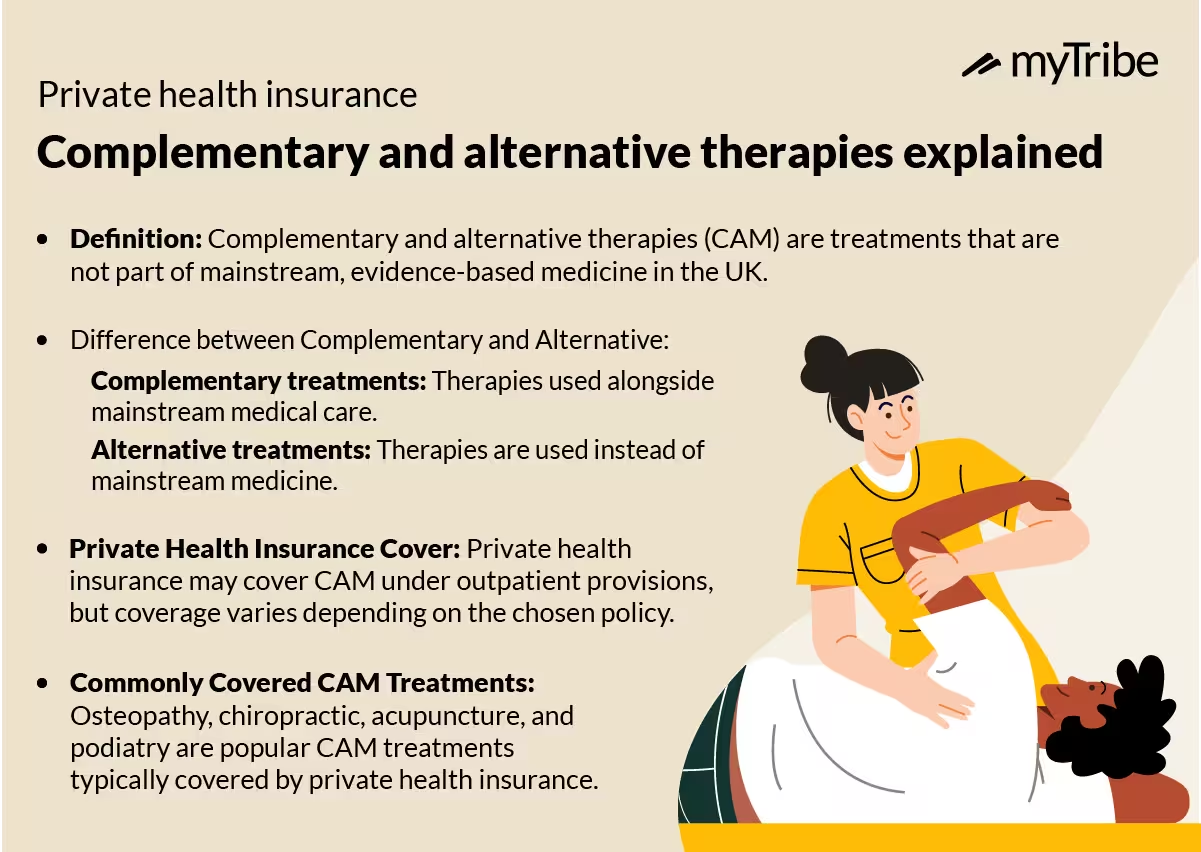Does private health insurance cover complementary and alternative therapies?
An essential part of private health insurance is to provide cover for acute conditions that can be effectively treated in hospital. On top of that, insurers may also offer you a range of additional benefits, either as standard or as an optional extra. Here, we look at complementary and alternative treatments and whether they’re included in private health insurance policies.


What are complementary and alternative therapies?
Complementary and alternative medicine (shortened to CAM) are treatments that sit outside scientific, evidence-based medicine. Fundamentally, it is anything not provided as part of mainstream care in the UK.
With that in mind, there may be overlap between the two. For example, if you have joint pain, your GP may recommend steroid injections or painkillers. If you choose to have acupuncture in addition to this, it would be considered a complementary treatment. However, if you decided just to have acupuncture and avoid steroids and painkillers, it could be viewed as an alternative therapy.
CAM covers a broad range of treatments, including:
- Acupuncture – this works by putting very fine needles into specific areas on your body (acupuncture points) in order to release natural pain-relieving chemicals.
- Osteopathy – this involves stretching, massaging and moving your body to improve mobility, muscle tension and circulation.
- Homeopathy – small, dilute amounts of natural substances are used on the body to encourage it to develop its own natural defences.
- Chiropractic – the relief of joint pain (such as neck, back, elbow, and shoulder) through manipulation of muscles, bones and joints.
- Podiatry – this therapy focuses on foot and ankle conditions, helping ease pain and improve mobility and circulation (for instance, for patients with diabetes).
These are just a handful of common examples, but CAM can also cover therapies such as aromatherapy, craniosacral therapy, and Reiki.

Private health insurance can include complementary and alternative therapies under your out-patient provision, but this will depend on the policy you choose.
Some policies may include certain complementary and alternative therapies as standard, or it could be a feature you can pay to add.
Be aware that there may also be limits to how much you can claim towards treatment. This could be restricted to a fixed number of sessions or a value (for example, up to £250). Some policies offer an unlimited number of sessions or value, but this is likely to be reflected in higher premiums.
Your insurer may also only pay out for certain types of CAM; for instance, chiropractic treatment may be covered, but Reiki or aromatherapy might not.
What CAM does private health insurance usually cover?
If your health insurance provider offers complementary and alternative therapies, they’ll set out what’s covered in your policy documents.
Popular treatments that are typically included are osteopathy, chiropractic, acupuncture and podiatry.
Who can I see for treatment?
You should check your policy documents in case your insurer specifies who you can be treated by. Usually, if the treatment is recognised and has a regulatory body, you would be expected to see a practitioner who is either licensed or has regulatory approval. A good example is chiropractic treatment, where chiropractors must be registered with the General Chiropractic Council in order to practice.
Complementary and alternative treatment can be beneficial. However, where a particular treatment works for one person, it may or may not have the same effect on you.
Complementary treatments that run alongside mainstream medicine can also provide you with a more holistic approach to your overall care.
Remember that CAM is considered outside of the mainstream because there may not be enough scientific data to show how effective it is. This doesn’t mean it won’t work for you, but it does mean you should research what’s available and who to see.
Before you have any treatment, you should consider:
1. Treatments you’re already having
If you’re being treated for something with mainstream medicine, consider how CAM might affect this. Not all alternative therapies will be compatible, and some may interfere with the treatment you’re already having.
It’s important to speak to your GP, nurse or other healthcare professional before having any other treatments. You should also let your CAM practitioner know about any mainstream care you’re having.
2. If practitioners are regulated
If you’re having treatment that is regulated, ensure that your practitioner is licensed or accredited. At the very least, practitioners should have appropriate qualifications.
If you’re not sure where to look, your GP may be able to help or recommend someone.
If the treatment you’re interested in isn’t regulated, check reviews on independent sites and don’t be afraid to ask questions if you’re unclear about anything. Professional and qualified practitioners will be used to this and shouldn’t mind giving you the information you need.
3. Potential side effects
You can have side effects with almost all treatments – mainstream or otherwise. Before you have any sort of treatment, you should be told what the potential side effects could be.
In most cases, you’ll need a few treatments before you see any benefits, so don’t give up immediately. However, if you experience any negative side effects, always let your practitioner know straight away.
Remember – speak to your GP or consultant before you have any treatment.
Most private health insurers offer some sort of complementary or alternative therapy, although you may have to pay extra for it. The fact that it is commonly offered highlights how popular these types of treatments are and shows that they’re valued by a fair proportion of policyholders.
Despite a lack of conclusive evidence, many people find CAM can improve mood and relieve anxiety, both of which can help boost your overall wellbeing.
If you want to find out more about private health insurance and what it can offer you, we can put you in touch with a regulated broker who understands the market and can take you through your options.
To give you a better idea of how private health insurance works, we’ve also put together these in-depth guides:
Disclaimer: This information is general and what is best for you will depend on your personal circumstances. Please speak with a financial adviser or do your own research before making a decision.
Frequently Asked Questions
Should I use alternative therapies?
Many people do find complementary and alternative therapies beneficial, whether to complement mainstream medical treatment or just for relaxation and their wellbeing.
That said, it’s a personal choice, and there’s no guarantee that you’ll experience the same benefits as someone else.
How do I find alternative and complementary treatments?
Recommendations from your GP, other health professional, or friends and family are a good starting point. Otherwise, check review sites rather than simply relying on practitioners’ websites.
Don’t forget to check if the therapy you’re interested in is regulated. If it is, look for practitioners who are registered or accredited.
When you find a practitioner, it’s worth making sure you’re clear about:
- What their qualifications are.
- How much they charge.
- How long until you can expect to see or feel results.
- Whether there are any side effects.
- What the complaints process is and what insurance they have.
- Whether there is anything that might prevent you from having treatment.








